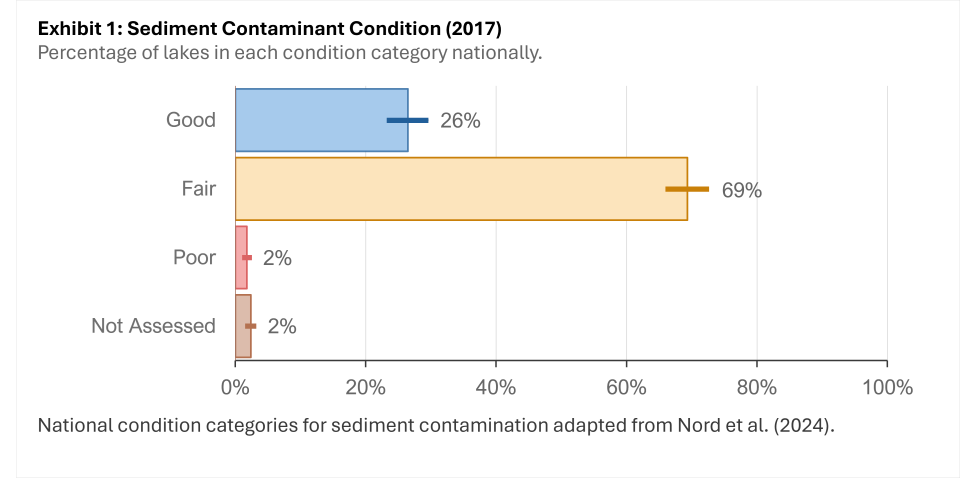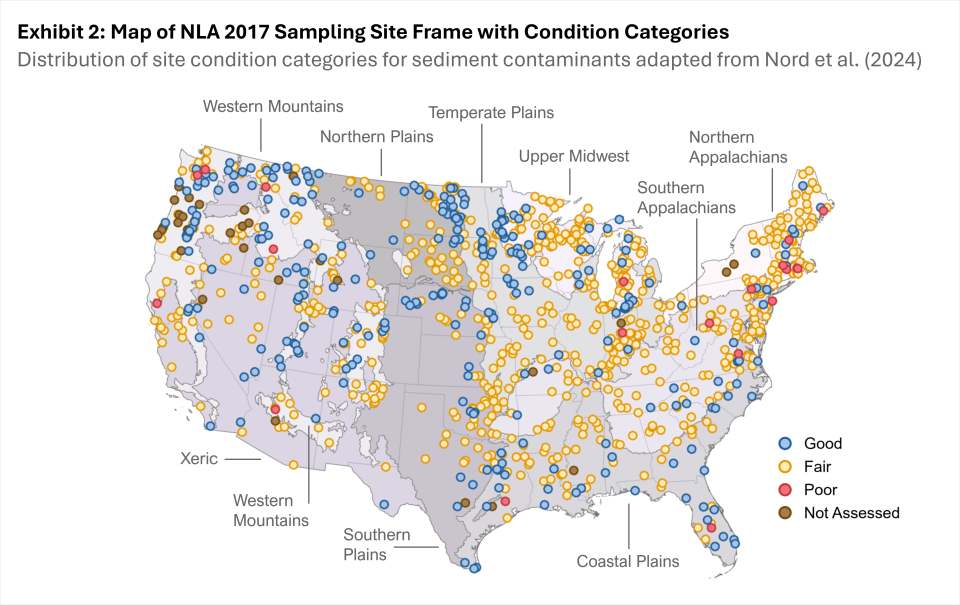National Lakes Assessment - Sediment Contaminants
The National Lakes Assessment, NLA, measures the chemical, physical and biological condition of lakes across the conterminous United States. In 2017, sediments were collected and assessed for sediment quality. This study was the first national scale sediment assessment for lakes in the U.S. (Nord et al. 2024) and expanded upon an NLA 2007 intensification, assessing sediment contaminants in the state of Minnesota (Crane and Hennes 2016; Crane 2017). The samples were compared to literature-based benchmarks similar to the National Coastal Condition Assessment. Additionally, Crane et al. (2021) used the data from 2017 to generate ambient sediment background values from which future data may be compared.

Photo: Sediment core collection. Credit: Siana Wong, Washington State Department of Ecology
Sediment Contaminants
Sediment contaminants are chemicals—which include metals, metalloids, and organic compounds—that have accumulated in the bottom substrate of aquatic ecosystems. These chemicals can enter aquatic systems naturally through processes such as bank erosion, mineral weathering, and natural oil seeps. Human activity including industrial, urban, and agricultural runoff; oil and chemical spills; and atmospheric deposition from coal burning and hazardous waste incineration can also lead to sediment contamination.
When metal and organic contaminants accumulate in aquatic sediments, they can pose a risk to both aquatic life and human health. Bottom dwelling invertebrates and fish can ingest contaminants, where they can disrupt development and reproduction cycles. These contaminants can also travel up aquatic food webs, posing a potential threat to people who eat contaminated fish and shellfish. By measuring sediment contamination and comparing levels to benchmarks, we can characterize the relative condition of lakes.
The NLA sediment contaminant indicator uses an effect concentration index to categorize lakes into good, fair, and poor categories. The probable effect concentration—the concentration above which adverse effects are likely— is used to assess the potential toxicity of a single contaminant. To determine the toxicity of multiple contaminants, the mean probable effect concentration quotient is calculated by averaging concentrations of individual contaminants by their probable effect concentrations (MacDonald et al. 2000). The mean PEC-Q for each site was calculated from seven individual metal(loid) PEC values—Arsenic, Cadmium, Chromium, Copper, Lead, Nickle, and Zinc—and the sum of seven low molecular weight PAHs—acenaphthene, acenaphthylene, anthracene, fluorene, 2-methylnaphthalene, naphthalene, and phenanthrene—and six high molecular weight PAHs—benz(a), anthracene, benzo(a)pyrene, chrysene, dibenz(a,h)anthracene, fluoranthene, and pyrene). Condition categories based on this index are defined below:
- Good: Lakes with mean PEC-Q ≤ 0.1
- Fair: Lakes with mean PEC-Q > 0.1 and < 0.6
- Poor: Lakes with mean PEC-Q ≥ 0.6
What was the condition in 2017?
Nationally, a majority lakes (69%) were in fair condition for sediment contamination. A smaller proportion of lakes were in good condition (26%) and a small percentage of lakes were in poor condition (2%)

How was condition distributed across ecoregions?
Across the nine different aggregated ecoregions, condition trends varied but were similar to the national results. For a more details on ecoregional results, please refer to Nord et al. (2024).

References:
USEPA. 2017. National Lakes Assessment 2017. Field Operations Manual. EPA 841-B-16-002. U.S. Environmental Protection Agency, Washington, DC.
Crane, J. L. 2021. Distribution and toxic potential of alkylphenols, nonylphenol ethoxylates, and pyrethroids in Minnesota, USA lake sediments. Science of The Total Environment. 776: 145974.
Crane, J. L., Bijak, A. L., Maier, M. A., Nord, M. A. 2021. Development of current ambient background threshold values for sediment quality parameters in U.S. lakes on a regional and statewide basis. Science of The Total Environment. 7936: 148630.
Nord, M. A., Maeier, M. A., Bijak, A. L., Crane, J. L., Pollard, A. I. 2024. Assessment of recent lake sediment condition in the conterminous U.S. Science of The Total Environment. 956: 177315.
